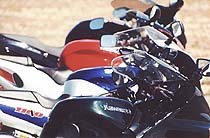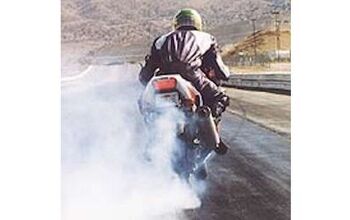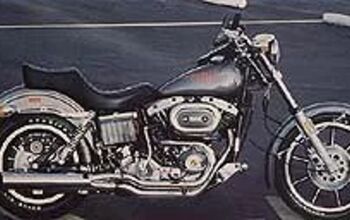Open Superbikes, 1997 - Motorcycle.com

Get the Flash Player to see this player.
So, to nurture our horsepower habit we stabled four of the fastest production bikes available today. Criteria? Simple -- 1000cc and over, equipped with full fairings. Who qualified? Honda's CBR1100XX, Kawasaki's ZX1100R, Suzuki's GSXR1100 and Yamaha's YZF1000. We had hoped to lasso Triumph's new T595 Daytona as well, but a machine wasn't available.
They say power corrupts, and absolute power corrupts absolutely. We can attest to this firsthand, because soon after our all-conquering sportbikes assembled, we were feeling pretty damn omnipotent. Tales of power-fueled antics were being swapped around the office. Managing Editor Tom Fortune came into work smiling as he proclaimed, "The Double-X rules! We did 155 mph two-up, with luggage -- and it was still pulling!" Editor-in-Chief Brent Plummer countered with: "No way! The YZF's awesome! I did a crossed up second-gear wheelie on the way to work!" The stories went on and on. . . .
Clearly, a shootout was in order so that we could pick one deity to stand above the rest. Only by putting these bikes through a series of performance contests would we be able to pick a winner. First, to the dyno room to measure horsepower, followed by racetrack testing at the Streets of Willow and quarter-mile runs at Los Angeles County Raceway. Next, miles of street riding were scheduled to measure real-world performance. To make sure all our contestants were on a level playing field, we outfitted each with sticky Metzeler MEZ1 radials. Finally, we brought in current Willow Springs lap record holder and defending Formula One Champion Chuck Graves, along with ex-Fast by Ferracci and current Motorcycle Online lead racer Shawn Higbee to help us find where the absolute limits of these machines lay.
Let's get ready to rumble!
1997 Kawasaki ZX-11And that's just fine with Kawasaki. If you're looking for something more track-worthy they'll be happy to show you their ZX-9. The ZX-11 has always been, and remains today, a fast and comfortable sport-tourer. It is far more plush than either the GSXR or YZF. If your own personal criteria in an open-class motorcycle leans towards a bike that can cruise two-up comfortably with luggage at triple digit speeds -- all day long -- then consider Kawasaki's mighty ZX-11 as having finished second in this shootout.
Manufacturer: Kawasaki
Model: 1997 Ninja ZX-11
Price: $10,599
Engine: Four-stroke liquid-cooled DOHC inline four
Bore and Stroke: 76 by 58mm
Displacement: 1052cc
Carburetion: Four Keihin CVKD40
Transmission: Six-speed
Wheelbase: 58.9 in.
Seat Height: 30.7 in.
Fuel Capacity: 6.3 gal.
Claimed Dry Weight: 514 lbs
Measured Wet Weight: 604 lbs
Measured Peak Horsepower: 129.3 at 10000 rpm
Measured Peak Torque: 78.4 ft-lbs at 8250 rpm
1997 Suzuki GSXR1100
Suzuki has learned not to mess with success. GSXRs have always been strong sellers and popular choices for racers, so why fix what isn't broken? Thus the GSXR arrives on U.S. shores once again with few changes save for Suzuki's usual BNG (bold new graphics) for 1997.
Suzuki's GSXR line has always been at home on the racetrack, so we weren't surprised when ours posted the quickest lap time of the day, narrowly edging the YZF1000 by just a few hundredths of a second. Its excellent ground clearance is its strong point, as is great feedback from the front end. These same qualities also made it a top choice for sport riding. Although it gives away as much as 14 peak horsepower to the competition, Suzuki's GSXR still posted a quick quarter-mile time of 10.42 at 130.11 mph.But when the road stops twisting, the fun ends. Around town or on straight roads the GSXR's odd "sit on top of it" (as opposed to sitting down in the bike) riding position that works so well on the track will have the palms of your hands and lower back screaming for a break within an hour. Also, the GSXR's buzzy and peaky powerplant lacks the midrange punch of its competition, a very desirable feature around town. More than any other bike in this test it tends to bake the rider in engine heat during stop-and-go driving.
Perhaps the biggest competition for Suzuki's 1100 is its own 750. At 122.6 bhp, the 750 is only spotting its big brother seven horsepower, weighs in nearly 100 pounds less, has a new-generation frame and cool styling, is quicker around a racetrack than the 1100 and better looking to boot. When you add in that it's also $1,200 cheaper, reasons for buying the 1100 wane.
Where does the 1100 have an advantage? Its potential. No other bike this side of a Harley-Davidson has more aftermarket support going for it. People have been racing GSXRs for years, and they've amassed a huge and loyal following. Want to build a 1340cc Formula USA bike? Buy a GSXR. Want a Pro-Stock dragbike? Same answer. If you're looking at a showroom bike as a simple starting point for a project, Suzuki's GSXR 1100 is the choice.
Manufacturer: SuzukiModel: 1997 GSX-R1100WVPrice: ,399Engine: Four-stroke liquid cooled DOHC inline fourBore and Stroke: 75.5 by 60mmDisplacement: 1074ccCarburetion: Four BST36 MikuniTransmission: Five-speedWheelbase: 58.5 in.Seat Height: 32.1 in.Fuel Capacity: 5.5 gal., CA - 4.9 gal.Claimed Dry Weight: 489 lbsMeasured Wet Weight: 551 lbsMeasured Peak Horsepower: 122.6 at 9250 rpmMeasured Peak Torque: 75.0 ft-lbs at 7000 rpm
1997 Honda CBR1100XX
Now that we've had our greedy hands on a Double-X we can say that the rumors were exaggerated - if only slightly. Honda's CBR1100XX, or Super Blackbird in other markets, does top out just shy of 180 mph, and it spins the dyno to a stunning 136.2 bhp. Even more impressive is the broad spread of power. After 3200 rpm, Honda's XX never makes less than 60 lbs-ft of torque with a peak of 81.6. On the horsepower side, how does 100 bhp at just 6750 rpm and over 130 from 8700 all the way to 10,750 rpm sound? Or how about a quarter mile time of 10.20 at 136.1 mph? Awesome!
While both dyno and dragstrip will tell you that the XX makes boatloads of power, they can't tell you how smoothly it makes it. At any rpm from idle to redline, this engine is completely devoid of any form of vibration. Period. How smooth is it? One of our testers, a rider with more than 10 year's experience, rode almost 15 miles at 65 mph down the freeway at a leisurely 4,250 rpm - before he realized he was in third gear!
This silky engine combines with one of the most unique fairing designs ever fitted to a sportbike to make the Double-X a high-speed sport-touring dream. At 80 mph, wind noise is barely more than a whistle, and there's no sign of buffeting or turbulence. Passenger comfort is also excellent, with stints of several hundred miles passing without complaint.

Motorcycle.com presents an unrivaled combination of bike reviews and news written by industry experts
More by Motorcycle.com Staff













































Comments
Join the conversation